Tooth discoloration is when the color of your teeth changes. They might appear yellowed or less bright, or they may develop white or dark flecks. Causes include tobacco use, dental trauma, poor oral hygiene and certain foods, drinks and medications.
Why is my tooth discolored?
Almost everyone wants to have a white, healthy smile. Your teeth might discolor for several different causes. Some things, including aging or childhood injuries that might disrupt the formation of our teeth enamel, are beyond our control. For this reason, it’s crucial to go through any plans you have for teeth whitening with your dentist.

Your dentist can assess if the stains on your teeth is only lifestyle-related staining, such as excessive coffee consumption or whether there is a more serious oral health issue at play. Despite the fact that bleaching is typically done for aesthetic purposes, your dentist may advise you on the best course of action for your particular stains. The good news is that erasing teeth stains is frequently possible. That justifies working toward a radiant white grin.
Surface stains on the tooth’s surface, genuine changes in the tooth’s composition, or a mix of the two can all lead to tooth discoloration. There are three basic types of teeth stains, according to dental professionals:
- Extrinsic Teeth Stains:
Extrinsic tooth darkening is the most typical kind of tooth discoloration. It happens as a result of exposing teeth to stains like:
- Tar and other chemicals are found in cigarette smoke.
- Foods that stain, including chocolate, berries, and others
- Liquids that are dark in hue, including coffee, black tea, colorful sodas, red wine, and dark beer
Not all foods that cause tooth discolouration are black in color, despite the fact that many are. Even if they are light in color, foods like apples and potatoes can stain teeth.
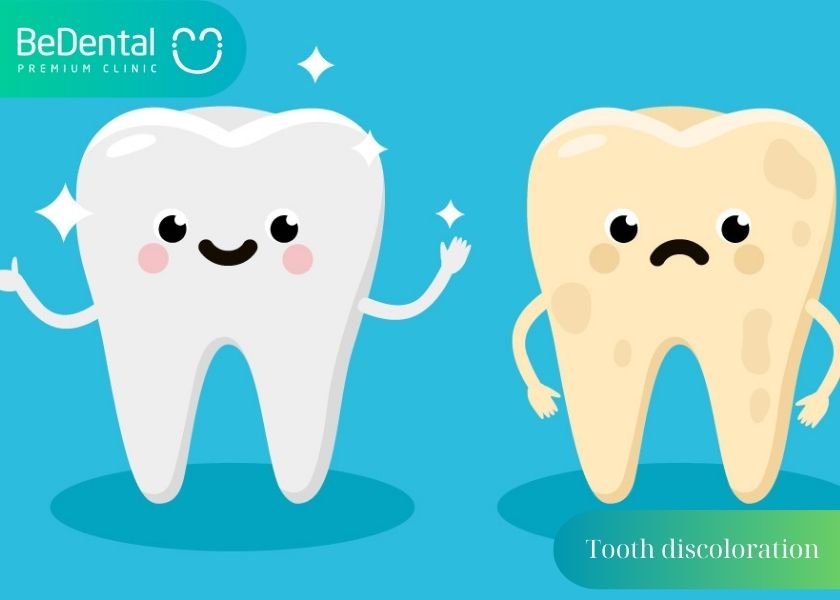
- Intrinsic Teeth Stains:
Numerous internal dental alterations can result in intrinsic discolored tooth. The cause of intrinsic tooth discoloration might be:
- Chemical or physical changes to the tooth: Physically, as we age, our dental enamel deteriorates, and when it does, the dentin, the tooth’s inner structure, is more readily seen. Individual differences in dentin color might result in teeth that are yellowish, brown, or grey in hue.
- Tooth discoloration after trauma: When a tooth’s pulp dies, the tooth may turn dark or even black. The tooth may also sustain damage before it erupts, resulting in inadequate enamel production and a discolored tooth. Additionally, tooth decay can stain your teeth.
- Some medicines and substances: Including doxycycline tooth discoloration or excessive fluoride exposure in infancy, can cause enamel abnormalities that show up as tooth discoloration.
The best way to treat intrinsic discolored tooth is with porcelain veneers or other procedures that cover the stained tooth enamel since intrinsic discolored tooth does not respond well to teeth whitening.

- Age-Related Teeth Stains:
The effects of both intrinsic and extrinsic tooth discoloration are combined in age-related teeth stains. Teeth darken as you age because the dentin, the tooth’s basic tissue, naturally ages. Age-related enamel thinning of the tooth makes the dentin more apparent.The majority of individuals’ teeth will yellow with age due to these inherent reasons of discoloration as well as external factors including the impact of specific meals, beverages, and smoke.
Causes of tooth discoloration
Tooth discoloration causes brought on by lifestyle choices:
- Some starchy meals like pasta or potatoes as well as coffee, tea, colas, and wines are examples of foods and drinks that might leave stains.
- Use of tobacco: Using tobacco for smoking or chewing can discolor teeth.
Tooth discoloration causes by dental health:
- A lack of dental hygiene: Plaque and food stains can accumulate if you forget to clean and floss your teeth. Skipping regular cleanings by a dentist can also cause stains to appear.
- Disease: Conditions that inhibit the healthy growth of dentin, the more porous “yellower” core beneath enamel, as well as dental enamel (your teeth’s white outer layer), can cause tooth discoloration. Chemotherapy and radiation to the head and neck are two medical procedures that can stain teeth. Some illnesses in expectant women can interfere with your baby’s development of enamel and stain their teeth.
- Medications: Certain medicines have long been recognized to stain developing children’s teeth. Tetracycline and doxycycline, medicines, can have an impact on how enamel forms in kids under the age of eight. Teeth can also become stained by mouthwashes and rinses that include cetylpyridinium chloride and chlorhexidine.

- Dental treatments:
One common cause is tooth discoloration after root canal procedure, particularly in front teeth. During a root canal, the removal of the pulp can cause the tooth to darken due to changes in the dentin or residual blood products within the tooth.
Front tooth root canal discoloration is more noticeable due to their prominent position. This can occur when the tooth loses its natural vitality or when materials used during the procedure affect the color.
- Aging: Your teeth’s outer coat of enamel wears away with age, revealing the tooth’s yellow dentin. As you get older, the dentin in your teeth also increases, which reduces the size of the pulp. The tooth becomes darker and loses some of its translucency.
- Genetics: Some families have thicker, whiter enamel.
- Environment: Too much fluoride can lead to fluorosis, which appears as white spots on teeth, whether it comes from environmental sources (high fluoride levels in water) or excessive usage (fluoride treatments, rinses, toothpaste).
- Trauma: Sports can cause mouth injuries in children. If they are younger than eight, the injury may prevent the production of enamel. Adults get discolored tooth by trauma if a sports injury or other impact reduces blood supply to the tooth or kills the nerve.
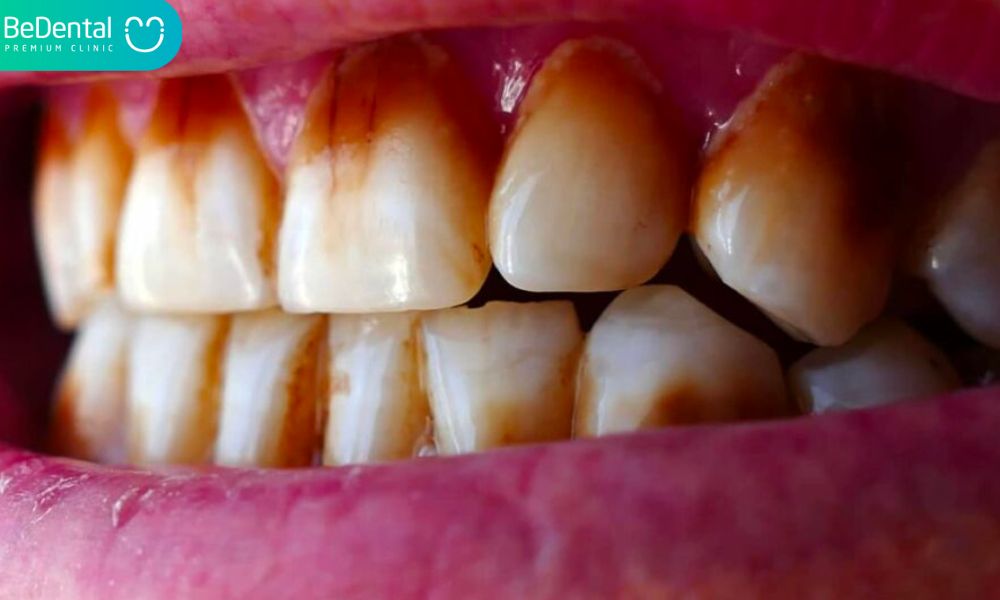
How common are discolored or stained teeth?
Although it’s unknown how many of us have tooth discoloration, it is clear that we are concerned with how white and strong our teeth are. As a type of social status symbol these days, a bright smile has made teeth-whitening goods and techniques rather popular. According to the American Academy of Cosmetic Dentistry, the majority of us (99%) believe that our smile is our most valuable social asset.
Any drugstore’s dental care section has a wide variety of whitening trays, strips, toothpastes, and mouthwashes. More than ever, we are backing up our words with actions by increasing our yearly expenditure on both over-the-counter and professional whitening goods and treatments. There are solutions for any budget if you’re ready to whiten your teeth, but it pays to know which ones are secure and efficient and which could cause more harm than good.

Can crowns or veneers, which are dental restorations, be made whiter?
It’s also crucial to realize that because dental restorations, such as bonding, veneers, crowns, bridges, dentures, or implants, are often made of man-made materials, such as porcelain, they cannot be whitened. Only teeth with natural enamel can be made whiter, and only then if your dentist thinks the underlying issue is correctable. Your dentist could advise one or more of the following alternatives depending on the reason for the tooth discoloration.
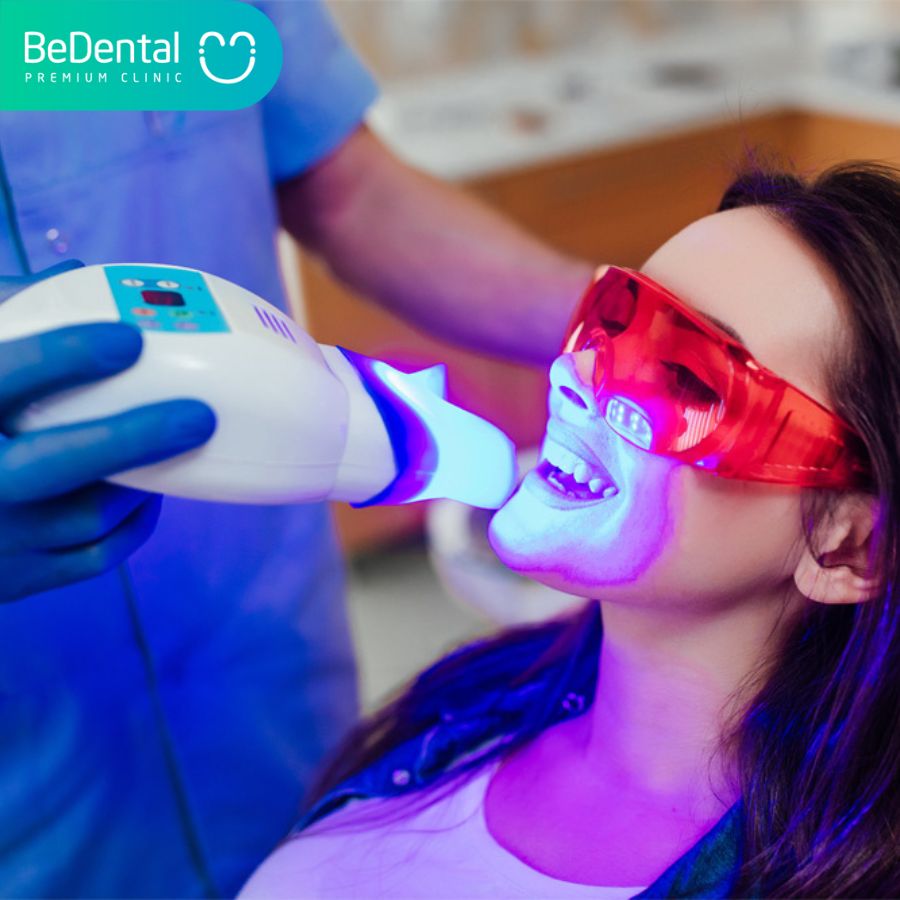
At-home teeth whitening:
- avoiding meals and drinks that cause stains.
- using the proper tooth brushing and flossing practices to clean your teeth every day.
Professional teeth whitening:
- Professional teeth whitening is carried out at the dentist’s office using expert whitening methods and products to hasten the whitening process. For some items, the bleaching process may need to be sped up with heat and specialized light. Other goods that are exclusively sold to professionals will have a stronger whitener concentration, maybe with a desensitizer, and a particular tray of some sort for better whitener adherence. The light “bonds” the resin to the tooth to improve the color and contour of your smile. Dental crowns may improve the color of your smile and are used to protect, cover, and cure broken teeth. The procedure is safe when carried out by a skilled dentist.
- Dental bonding is a process in which your dentist coats your teeth with a white resin and uses a special curing light to solidify it.
- Dental crowns are used to cover, protect, and treat fractured teeth. They can also help your smile look whiter. Your dentist could alter the color of a crown so that it blends in with your teeth.
- Dental veneers are specialized porcelain “shells” manufactured to cover the front of the teeth and enhance their color and form. They are little and thin, similar to a fake fingernail, making them delicate. Your dentist would advise you to avoid biting into hard foods with your front teeth if you decide to have veneers in order to prevent damage.
How to fix one discolored tooth at home?
How to fix one discolored tooth at home? Here are some dos and don’ts of DIY whitening:
Don’t try:
- Fruit is delicious to eat yet bad for your teeth. Citric acid, which is found in fruit, should never be used since it removes enamel. Avoid it and reserve the acid for eating or cooking if the magazine you’re reading instructs you to use anything naturally acidic (such lemons, oranges, or apple cider vinegar).
- Activated charcoal or a baking soda-hydrogen peroxide paste. The enamel that is essential to having healthy, white teeth can be worn away by baking soda’s abrasive nature. The second layer, the more porous yellowish dentin, will be visible if you lose too much enamel. Your teeth may become more discolored and vulnerable to stains and cavities as a result.
- Oils and spices have appeared in publications and online offering to naturally whiten your teeth. Sadly, the American Dental Association states that there is no proof that turmeric will make your teeth appear whiter, and there is also no proof that “pulling oil” ( If you put coconut oil in your mouth, it won’t make your teeth seem any whiter). You should save both for cooking.
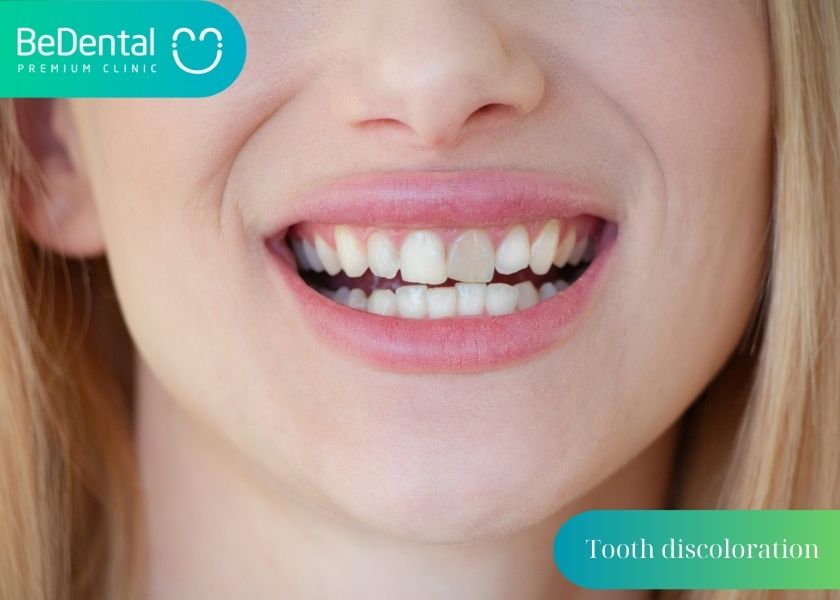
Do try:
- Prior to going to bed, and again when you wake up, spend two minutes brushing your teeth.
- To be safe, choose the proper paste. The American Dental Association (ADA) Seal of Acceptance should be included on whitening toothpaste. It is therefore dentist-endorsed.
- Every day, floss between your teeth.
- Avoid foods and beverages like cola, coffee, tea, and red wine that can minimize tooth discoloration.
- Always have a clean, reusable straw on available while drinking beverages to prevent staining your front teeth.
- Drink some water and rinse your mouth after ingesting an acidic or possibly staining beverage, such as juice, lemonade, coffee, or red wine.
- To avoid cigarette stains, stop smoking.
How can I prevent tooth discoloration?
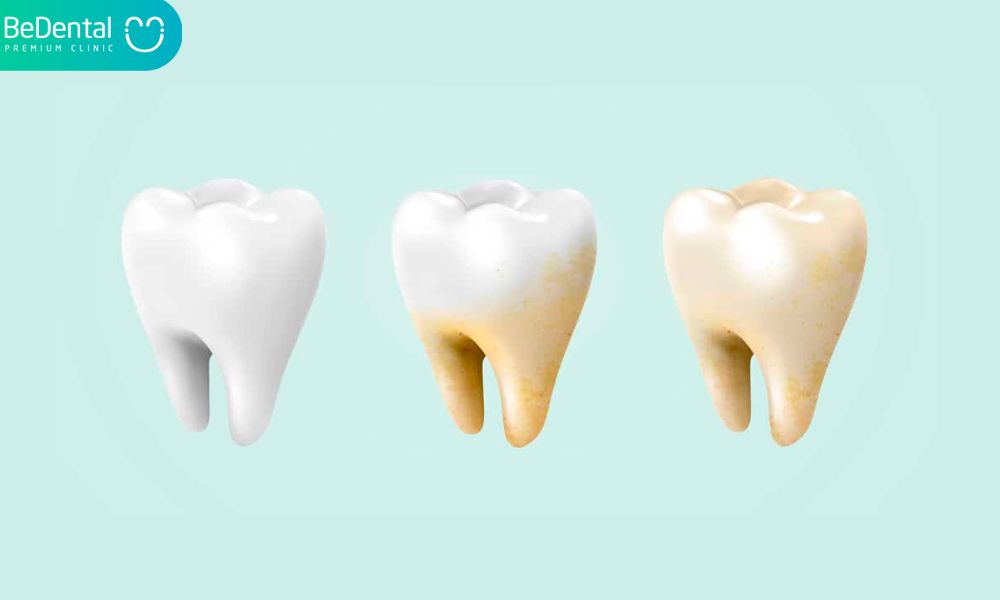
Maintaining good oral hygiene requires the development of healthy habits. You might be able to stop tooth discoloration with only a few straightforward lifestyle adjustments. If you drink a lot of coffee, you might want to cut back or switch to another beverage. Additionally, if you smoke, get assistance to quit because smoking harms a lot more than just your dental health.
You may improve your oral hygiene by brushing, flossing, and scheduling regular dental examinations and cleanings every six months. If you have other symptoms and your teeth continue to have an unusual color despite your best efforts to practice appropriate dental hygiene, schedule an appointment with your dentist.
See more
Teeth Whitening: Price, Procedure And Everything You Need To Know
In-Office Teeth Whitening and 5 Steps To A Bright Smile
Scaling and Polishing – Deep Oral Cleaning and 5 Habits To Keep Teeth Healthy
Tartar and 6 ways to prevent its return
Tư vấn chuyên môn bài viết:
BÁC SĨ DƯƠNG THỊ THÙY NGA






Pingback: Jaw fatigue: 4 things you should know – Be Dental
Pingback: Cost of Zirconia crowns/veneers: Ranging between $800 and $1,500. – Be Dental
Pingback: Zirconia veneer and 6 common concerns – Be Dental
Pingback: Tekka implant and 3 significant advantages – Be Dental